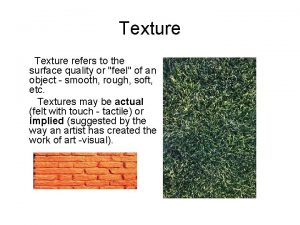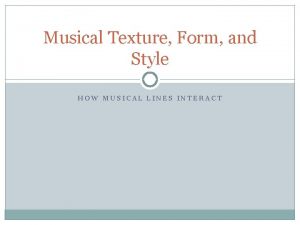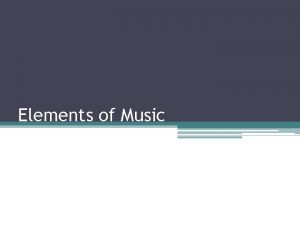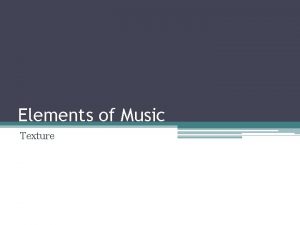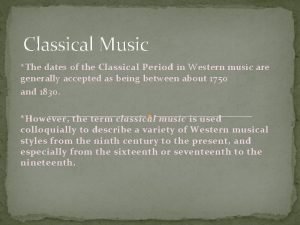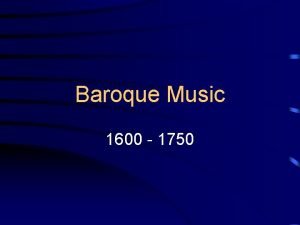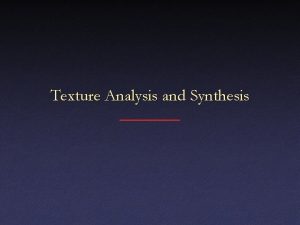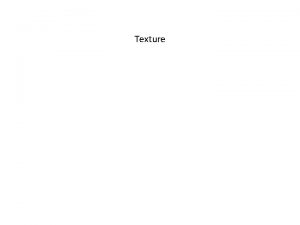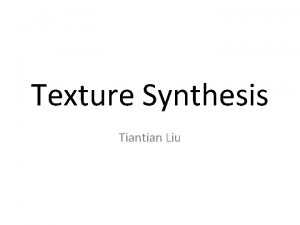Texture AP Music Theory Mr Silvagni What is









- Slides: 9

Texture AP Music Theory Mr. Silvagni

What is Texture in Music? • Music texture is how much is going on in the music at any given moment • Overall, it describes the relationships of melodies and harmonies in a piece of music • Counterpoint – distinct musical lines that sound harmonious when played together…focuses primarily on melodic interaction – This is the composing a bass line free response question

Monophony • Monophony – music that has only one melodic line, with no harmony or counterpoint – there may be rhythmic accompaniment, but only one line with specific pitches – Ex. Solo instrument performance or a choir singing all in unison – NOT to be confused with monody, which refers to a solo vocal style distinguished by having a single melodic line and instrumental accompaniment.

Homophony • Homophony – one clear melodic line with accompaniment – Accompaniment parts may still have melodic interest – Accompaniment may use counterpoint – Ex. Choral music in which the parts have mostly the same rhythms at the same time; barbershop quartet; Protestant hymns – Chordal Homophony – every line or voice moving together with exactly the same rhythm

Homophony – Melody with accompaniment – one clear melody line, but the melody is not limited to chords moving together – Ex. Singer with guitar, small jazz combo, piano solo • Types of accompaniment • Ostinato – short melodic, rhythmic, or harmonic pattern repeated • Alberti bass – broken chord bass line, usually (Do-Sol-Mi-Sol) or something similar • Walking bass – a regular quarter-note movement similar to feet walking…rises and falls…mostly found in jazz • Ragtime – features syncopated rhythms over straight rhythms…early 1900 s piano music

Polyphony • Polyphony – more than one independent melody is occurring at the same time – Pure counterpoint/contrapuntal – Ex. Round, canon, fugue – Imitative Polyphony – various melodic lines sound similar – Nonimitative Polyphony – various melodic lines sound independent of each other – Countermelody – a secondary melody or line played simultaneously with a more prominent melody – Fugue – theme or subject is introduced by one voice and is imitated by others (fugal imitation)

Heterophony • Heterophony – one melody line, but different variations of it are being sung or played at the same time – Ex. Bluegrass, Cajun, and zydeco – Other ex. Middle Eastern, South Asian, central Eurasian, and Native American music may have

Other Terms • Solo – single performer or a passage to be performed by a single performer • Soli – directive to perform an indicated passage of a composition with an entire section of an ensemble • Tutti – all members play

Listening Examples Musical Texture in Rock Music http: //www. lipscomb. umn. edu/rock/Texture. htm AP Music Theory: Music Texture https: //www. youtube. com/watch? v=_J 2 R 20 X 16 Jc
 Music music music
Music music music Texture refers to the way something
Texture refers to the way something Homophonic vs polyphonic
Homophonic vs polyphonic How to describe texture in music
How to describe texture in music Definition of texture in music
Definition of texture in music Less complicated texture than baroque (more homophonic)
Less complicated texture than baroque (more homophonic) Renaissance period characteristics music
Renaissance period characteristics music Give the dates for the classical period.
Give the dates for the classical period. Terraced dynamics are
Terraced dynamics are Texture refers to loudness and quietness of music
Texture refers to loudness and quietness of music

